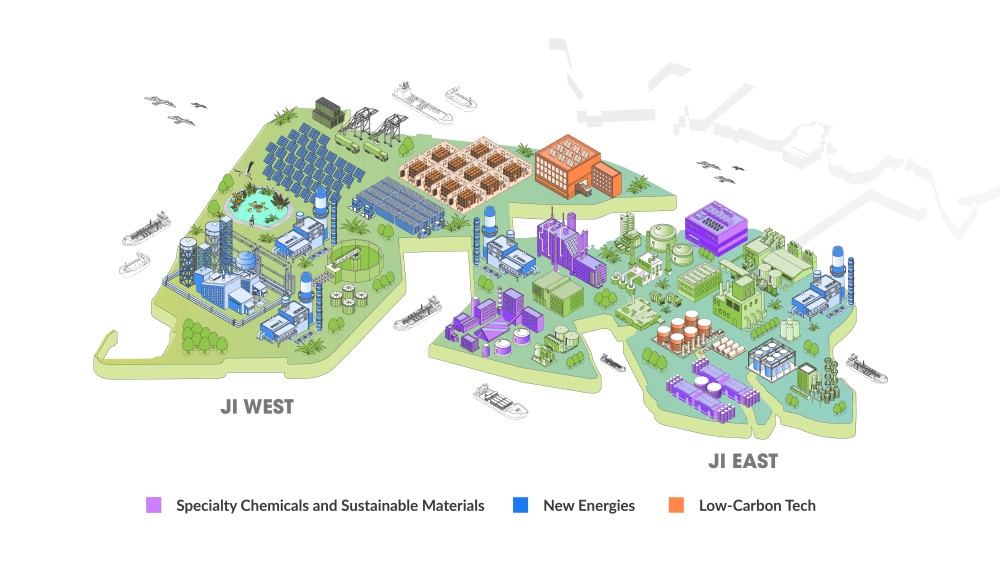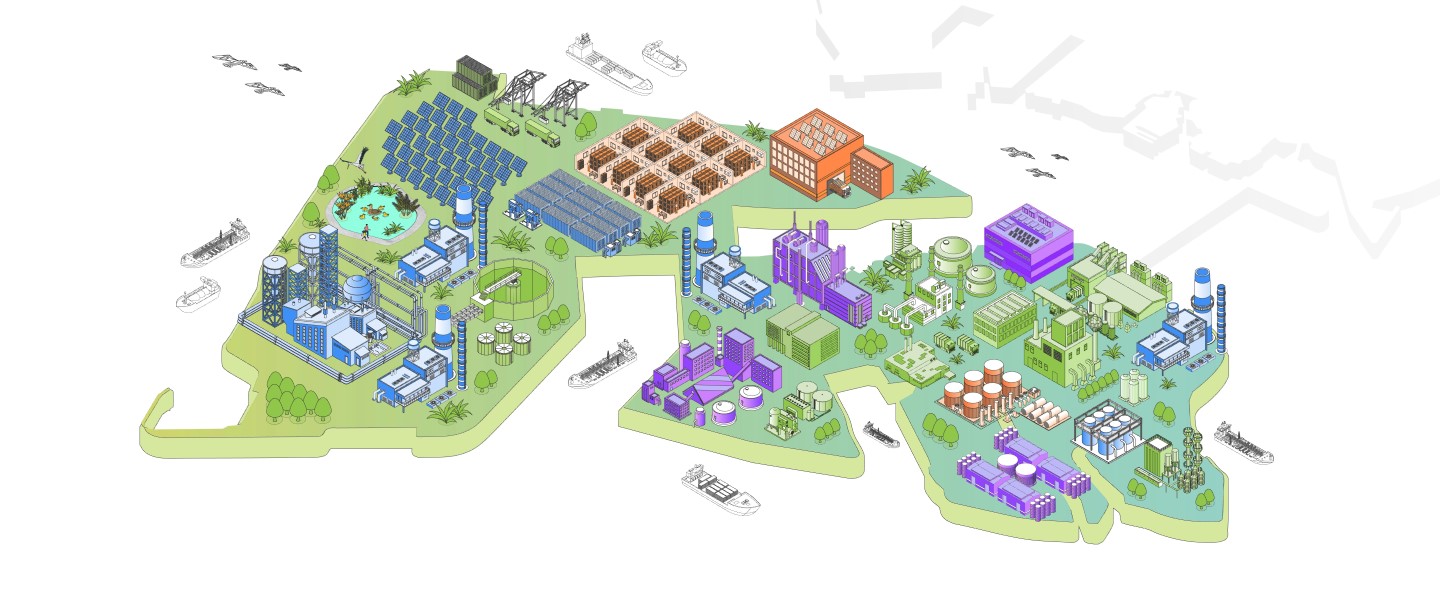Evolving to embrace sustainability and seize opportunities
Since the industrial revolution, the global energy and chemicals industry has powered the way we live, work, and innovate. From fuels and plastics to pharmaceuticals and electronics, advancements in the industry have been central to progress. As the world grapples with climate change and governments drive ambitious sustainability goals, there is a growing need for the energy and chemicals industry to embrace sustainable and low-carbon solutions while meeting a rising demand.
In Singapore, where the energy and chemicals sector is the second-largest sector in the manufacturing industry, this transformation is being realised on Jurong Island. Built from seven reclaimed islands just off the southwest of the mainland, Jurong Island is now home to more than 100 global energy and chemical companies. As global challenges reshape the industry, the island aims to capture opportunities in specialty chemicals and sustainable materials, new energies, and low-carbon technologies.

Driving industry growth in specialty chemicals and sustainable materials for the future
Global megatrends are transforming the chemicals landscape. A rapidly expanding middle class in Asia spurs demand for higher-quality products across consumer goods, pharmaceuticals, electronics and advanced materials. At the same time, international climate goals drive demand for bio-based polymers, low-carbon coatings and green solvents.
Jurong Island is positioned at the heart of this growth. With an integrated ecosystem, deep supply chain capabilities and access to skilled talent, the island is a regional hub for speciality chemicals and sustainable materials.
Since 2021, over 20 new specialty chemical projects have been established. These investments are expected to create more than 1,000 new jobs across manufacturing, process engineering, sustainability, as well as research and development.
Among them is Japanese manufacturer Kuraray that announced a US$410 million investment to build a plant producing Ethylene-vinyl alcohol (EVOH), a high-performance copolymer used in food packaging. Multi-national specialty materials manufacturer, Arkema, also opened the world’s largest integrated factory dedicated to advanced bio-circular materials, expanding global capacity for production of the company’s polyamide 11 by 50%.
Similarly, Cariflex, leading producer of synthetic rubber latex has launched a new plant that will double its global production capacity, while Evonik has opened a new alkoxides production facility to supply catalysts for biodiesel and pharmaceuticals.
These investments deepen the island’s manufacturing base and diversify its portfolio into higher-value, sustainable products. Longtime industry leaders such as ExxonMobil and the Petrochemical Corporation of Singapore (PCS) are also upgrading their refineries to produce cleaner, higher-value outputs, including projects that convert residual crude into premium lubricants. With its integrated networks and collaborative environment, Jurong Island enables companies to develop innovative materials and scale up solutions for Asia’s markets, strengthening Singapore’s position as a forward-looking chemicals hub.
Building a global testbed for new energies and low-carbon technologies
As a resource-constrained nation, Singapore has limited access to natural energy resources. To achieve the country’s goal of net zero by 2050, Singapore must diversify its energy mix and Jurong Island is where some of these new energy pathways are taking shape.
Jurong Island is becoming a global testbed for next-generation fuels such as Sustainable Aviation Fuel (SAF), hydrogen and ammonia — all essential for decarbonising hard-to-abate sectors like aviation and maritime transport.
Keppel and Sembcorp are also advancing Singapore’s energy transformation through new hydrogen-ready Combined Cycle Gas Turbines (CCGTs) on Jurong Island. These advanced turbines can operate on natural gas blends and transition to pure hydrogen as technology matures, aligning with Singapore’s National Hydrogen Strategy.
Meanwhile, Advario and local renewable energy storage start-up VFlowTech are collaborating to scale up vanadium redox flow battery systems to 40MWh, enough to power more than 3,000 homes daily. This partnership enhances energy storage capabilities and supports grid stability for low-carbon electricity.
On top of the numerous companies developing new energies on Jurong Island, JTC has also continued its SolarRoof and SolarLand programmes where rooftops and vacant land on its estates are transformed into sources of clean energy.
Such projects highlight Jurong Island’s role as a living laboratory for clean energy innovation—where companies, researchers and government agencies work together to pilot new solutions that can be scaled globally.

Supporting low-carbon technologies
Across carbon capture, electrification, energy efficiency and circular plastics, low-carbon solutions are increasingly piloted and scaled on Jurong Island. Leading companies are tapping into the island’s integration of utilities and cross-company networks that make it an ideal site to deploy low-carbon technologies at scale.
Global specialty chemicals leader Croda and local start-up NanoSun have piloted an advanced wastewater treatment facility that will reduce Croda’s freshwater dependence and cut emissions by 25%. The partnership emerged from the JTC and Enterprise Singapore Jurong Island Innovation Challenge.
Singaporean urban development company, Sembcorp, is working with US energy company, Bloom Energy to pilot solid oxide fuel cell and carbon capture technologies, potentially generating reliable, low-carbon electricity for industrial users.
Complementing these initiatives and partnerships, A*STAR will launch the Low Carbon Technology Translational Testbed (LCT³), a $62.5 million facility that offers modular, cost-effective test-bedding for emerging technologies. This platform will accelerate the commercialisation of innovations that can reduce industrial emissions.
By providing the infrastructure and facilitating these projects, Jurong Island bridges economic growth and environmental responsibility. To further enable Singapore’s industry to decarbonise while maintaining competitiveness, roughly 20 hectares of land have been set aside for a data centre park on Jurong Island, where operators can draw on shared utilities, renewable systems and emerging carbon abatement technologies.
Powering the future of low-carbon innovation together
As Singapore works towards its net zero ambitions, Jurong Island will continue to bring together global companies, innovators and researchers to test, develop and deploy solutions for the world.
The energy and chemicals industry is a key pillar of Singapore’s economy, and supporting its continued growth and transformation remains vital. Jurong Island’s vertically integrated structure (where the output from one plant becomes the input for another), coupled with a unique plug-and-play environment, continues to create production synergies that will assist companies to explore clean technologies and solutions in circularity.

